By: Richard Mann
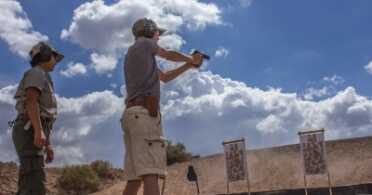
This handgun shooter is employing an almost perfect Weaver stance. By working one-on-one with an instructor, students can have time to work with various positions in order to find one that best suits them.
There is no shortage of variations in the training methods and doctrines employed when it comes to the defensive handgun. These differences apply to not just the doctrine that is taught but also to the methods of instruction. The point of this article is not to offer one method or doctrine as the best, but to point out some common shortcomings of traditional shooting classes and suggest additional or alternative ways to improve your shooting skills.
Which Stance is Best?
There has been a long-running debate with regard to which stance is best for defensive shooting, Weaver or isosceles. Could both be wrong? Yes and no. Here’s the thing: when it comes to what exactly is the Weaver or isosceles stance, there is no written-in-stone definition. Both stances have morphed over the years, if in fact there ever really was a firm – original – definition. Gunsite, the leading firearms training facility in the world, believes the Weaver stance is the way to go, while most of the successful competition shooters employ some form of what would be considered an isosceles. If you get down to brass tacks, the only real difference is the way the support arm is used. With the Weaver stance the support arm is bent at about a 90-degree angle to help with rearward force on the grip of the handgun. In the isosceles stance, both arms are held in the same way, either with the elbows locked or with them very slightly bent.
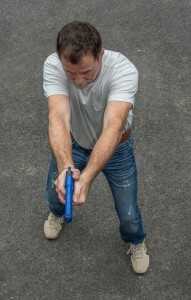
Which stance is best, Weaver or isosceles? It will vary from shooter to shooter and often something in between will prove superior.
In fact, something in between these two stances will work the best for most shooters. To shoot accurately and with speed, you must control your handgun but you must also be comfortable, and we are all made and move differently. When an instructor starts to insist that you get into a stance that is uncomfortable – just so you can do it like they do – they are not doing you any favors. Yes, you should try every stance to see which works best for you, but in the end you need to develop a stance that works with your body. Very likely this stance will be something between the accepted Weaver and isosceles stances. After 30 years of defensive handgun shooting, that is exactly what I have adopted. I shoot what might be called a modified Weaver or a hybrid isosceles. If you watch most of the shooters who are good with a handgun – guys like Max Michel – they have all tweaked these standardized positions to work for them.
I believe it is a mistake for a defensive handgun training course not to encourage students to try multiple and varied stances in order for them to see what works best for them.
Shot Count
Some shooting schools advertise that you will shoot a lot of ammo if you attend their course. Hey, this sounds great, right? We all like to shoot. However, there is a problem with this. Experience has shown that after firing somewhere between 150 and 250 rounds in one day, most shooters will reach the point of diminishing returns. Their bodies get tired, their arms ache and their grips lose their rigidity. I know of a training course where you will fire as many as 400 rounds in one day. Now, if you shoot a lot, like hundreds of rounds per week, you can probably hang in there. But if you are an average person looking to get quality instruction and improve your skills, shooting 400 rounds per day is not the way to get there.
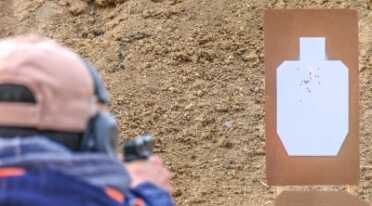
Don’t discount the use of lasers on a defensive handgun. They can help with live and dry practice and ultimately if you encounter a real threat.
Actually, you can vastly improve your shooting skills by only shooting 150 rounds per day. The key is dry practice and using laser training devices. Controlling recoil and dealing with the constant explosion at the end of your pistol’s barrel wears on your physical stamina and your mind. You can pull the trigger twice as many times during dry practice before you experience the same level of fatigue. In addition, you can also use dry practice to develop other skills like reloading, presentation and movement. If you enroll in a defensive handgun training class, don’t be discouraged if the instructor says, “We are going to do a lot of dry-practice.” It could very well mean that you have chosen the right class to spend your time and money on.
I believe it is a mistake to shoot more than 250 rounds per day while conducting defensive handgun training unless shooting a defensive handgun is something you do almost every day.
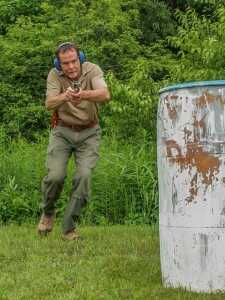
: Movement to cover or concealment should be an integral part of any defensive firearms training program.
Movement
Have you ever tried to shoot a moving target? It’s not that hard if the distances are short, but it is harder than shooting a target that is not moving. To steal a line from my friend Sheriff Jim Wilson, “In police work this is something we call a clue.” And the clue is that if you are moving you are a harder target to hit. If you are ever confronted with an armed assailant, you should shoot and move or move and shoot but you should never stand in one place, all Wild Bill Hickok like, and shoot it out. Where should you move to? Preferably cover. In the absence of cover, choose concealment. In the absence of concealment, choose anywhere. How should you move? As fast as you can. Yes, you shoot more accurately when you’re still, but when you’re done shooting and start the assessing process you should also be moving. Once you have mastered sight alignment and trigger control and are proficient with presenting your handgun and reloading it, every drill you conduct should include movement. You should move either before you shoot, after you shoot or while you are shooting, and I’m not talking about taking a single step, though even taking one step is better than standing still. When you start a drill, you should have various cover and concealment options at your disposal and you should utilize them every time.
However, most defensive shooting schools incorporate minimal movement into the training. Why? It’s not because they are stupid and think movement is not important. It’s that most defensive handgun schools train with a group of students on the line at the same time. From a safety standpoint, you cannot have students running all over the range shooting at the same time. This would lead to two things: somebody with an extra hole and a lawsuit. Therefore, you will most likely have to train with your instructor in a one-on-one situation to make sure you don’t put other students in danger while you are moving. The problem is that at a shooting school this process would seriously bog down training. The answer is to take a tutorial or a one-on-one training class. Gunsite offers tutorials like these, and yes, they are more expensive. However, the return for your investment is much higher. Alternatively, at least when you are practicing on your own, make sure you incorporate movement.
I believe a defensive handgun training program of instruction that is not based on movement is lacking.
Scanning
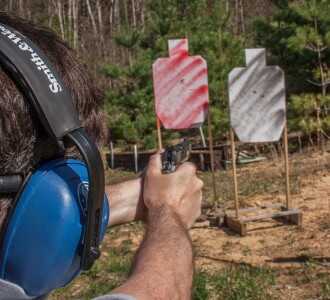
By using colored targets to supplement your primary target, you can make the scanning you do after the initial engagement meaningful.
Scanning – looking to the left and right after you engage a target – has become the en vogue thing to do on the range. On its face it makes sense. In a real defensive situation you’d best be looking around – 360 degrees around – before you holster up. When it gets bad, it generally gets bad all over. The problem is that on the range we are never looking for something that might actually be there. We just move our heads from left to right acting like we are looking for something we know is not there. We fight the way we train. The worst thing we could train to do is to turn our head this way and that and not actually look. Are we building a conditioned response that is prudent in theory but reckless in reality? The solution is really simple but difficult to facilitate on your own. We need to scan, but we need to scan and sometimes see things that drive different reactions.
If we are conducting drills to improve our gun handling and marksmanship skills, then let’s not muddy the waters with a reckless, conditioned response. My brain is smart enough to figure out that when I look left and right, I’m not going to see anything I need to address, so there is no reason to twist my head except for fear a range officer will fuss at me. With no possibility of seeing things that will dictate different responses, scanning is about as meaningful a politician’s promise.
Short of pop-up shoot / no-shoot targets, with just a little creativity you could position targets to the left and right with numbers or colors on them. A training partner could call out a color or number immediately after you engage the primary threat. Then you could “scan” for that color or number and react as needed when and if you see it. You may not have a training partner, so you need something else to look for. Gunsite Instructor Dave Starin gave me a good idea when it comes to scanning. After you engage a target and consider the target neutralized, look around – with your handgun following your eyes – for something. What kind of something? Well, that depends on where you are. Look for other targets, bugs, empty cases down range, red leaves, flowers, zombies; it really does not matter. Look for something.
If you don’t see what you are looking for, proceed as the training situation dictates. If you do see what you are looking for, then have a predetermined reaction. You could say, “bang” or “stop” or you could re-engage the target. Just mentally and physically acknowledge that you have searched your immediate area and did not see what you are looking for. Instructor Chris Wear conducted an experiment during one of my visits to Gunsite. While working with turning targets, Chris wrote numbers on each target. After the drill, he asked the students to tell him the number on the target to their left. No one – I repeat – no one could do it and everyone had scanned as they had been instructed…They just did not see anything.
I believe that defensive handgun schools that have you scan and look for nothing are teaching a conditioned response that is dangerous. Scanning is not done to look cool, it is done to see things.
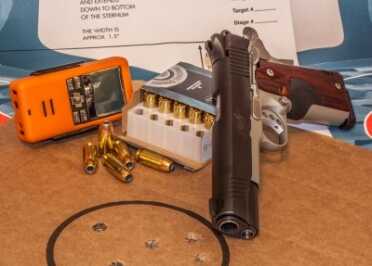
If you cannot afford to attend a quality training course, you can still conduct meaningful training on your own.
Fixing the Problems
As far as shooting schools are concerned, fixing some of these problems is a hard hurdle to get over. Shooting schools primarily exist to make money. Those not in the business of collecting a tuition, like the military and the police, still have financial considerations. They need to get as many trainees through a course as fast as possible so that they can maximize the taxpayer money they have been allotted. Neither of these approaches is conducive to providing the best training possible. That leaves you with two options; seek out a one-on-one tutorial or work through these problems on your own. The first would be preferable but will require deep pockets and with the cost of life these days, not many of us have pockets deep enough to even get all of a hand in there.
Keep this thought in mind: shooting a lot of ammo and learning how to look cool as you do it has nothing to do with the quality of instruction you will receive from a defensive handgun school. Common sense and the school’s ability to teach it do. Choose your training wisely; in the end it could make all the difference.
Follow Richard on his blog at: https://empty-cases.com. You can order his book, Handgun Training for Personal Protection direct from Amazon.com.

The funeral director who handled Trayvon Martin’s body also casts doubts on the Zimmerman story, saying there was no evidence of bruising
or scraping, consistent with a fight on the teen’s hands.
Tasers are most commonly utilized by law enforcement
officials in United States to subdue assailants.
Knowing what to do can be difference between being seriously injured, raped or
even killed and being able to escape without harm.
Great article. As an instructor, I can’t agree more with recommending that students do as much dry fire practice as possible. I do 2-3 times the number of dry fire drills a week as I do love fire. I teach a 6-8 hour defensive pistol course based on the Reactive Shooting method developed by Bill Rogers.
I have noticed a big difference in the performance of my students when we break the class into two sessions: a 2-3 hour classroom session to learn the technique, followed immediately by a 1-2 hour range session. Then, a few days latter by a second 1-2 hour range session after the student does an hour or two of dry fire practice. The results are actually amazing. The students who do the dry fire practice perform fantastically on their second range session. Conversely, the students that do not do the dry fire practice spend most of the second range session just where they left off during the first.
I love shooting and shoot every week for fun. Every time I shoot, I also incorporate 30-45 minutes of drills. Usually timed shots from low extended confirmed ready, from the transition and magazine change drills. I suggest anyone interested in shooting well defensively invest in a shot timer that does par timing. Work on shooting from low extended confirmed ready accurately in .5 seconds or less, from the transition accurately in 1 second or less and magazine change drills in 3 seconds or less.
If you are hitting those times you are doing well. If not, get some training. The $100 you spend learning to improve your technique will save you $1000’s of dollars sending ammo downrange poorly.
Brilliant and intelligent piece of writing. Many of the same topics I have pondered in my years especially the complexity issues of realistic training.
Great article – some good points. Introducing newcomers to the basics is important – the personal touches can come later. I’ve taken classes at Front Range, Northwest Personal Protection and a local outfit Practical Edge. All are very similar and all stress the need to dry practice and mastering the “surprise break”. We do shooting drills about every other weekend to stay sharp.
And Rodger, I shoot a Sig P226 and a Glock 23, both in 40SW and have easily put well over 2000 round thru them and have never had a malfunction. You are experiencing way too many for a self defense weapon. For your own safety, you need to have it looked at. Speaking of malfunctions and not mentioned in the article is the importance of knowing how to effectively and quickly clear all three types of malfunctions so you can quickly get back into the fight.
A note, if I may?
Order of training…..
1. Basic handgun – learn the basics; safety, operation, laws, stances, aiming, preferably a scenario or two, etc. Typical CCL courses.
2. Defensive handgun – review of basics, movement, retreat/evacuation from situation, advanced scenarios geared toward civilian encounters, etc. Advanced CCL courses.
3. Tactical handgun – review of basics, movement, engageing/advancing on target, advaned scenarios geared toward LE/Mil/Sec duty. Job specific training.
Just my two bits worth. I’m sure someone will want to argue about it.
The first thing that came to my mind was a question. I’d never thought about it before, nor had I seen anyone else raise it in disscussion of similar articles. Are we talking about “defensive” shooting, or “tactical” shooting? To put it another way, are we discussing techniques for the “average Joe/Jane” or police, security, and other folks who are (or will be) in harm’s way on a regular basis? Sounds like the latter to me, and I imagine that Robert Carpasso’s comment is along the same line of thinking.
My $0.02 Most shooters make the mistake of relying on sight’s and sight alignment. In my opinion sights should only be used at distance preferably with cover. Combat point shooting is the way to train for an actual shooting. If you talk to anyone who has been involved in a critical incident, shooting, the majority will tell you the same thing. I never used or saw my sights. Your brain is wired to focus on the threat not your firearm. Having been involved in a shooting I can tell you I never thought about or saw my sights. Taring the way your body and mind will force you to react in a critical situation only makes sense. I also agree with the dry fire method of training. I have several students each year come through my courses. All of the agency’s that collectively do well have one thing in common. They pull the trigger more than others. Some with live fire, and some with dry fire and I would say the dry fire guys have better trigger control. And I agree with most of you in that you must move and shoot, crawl before you walk, remembering we can only move as fast as we can shoot accurately. The article had some great points and at least made me think about firearms philosophy.
Again, it’s not all or nothing. “…practicing sighted fire will improve your unsighted fire, but it doesn’t work the other way around….” http://pistol-training.com/archives/9306
http://firearmusernetwork.com/2009/04/01/point-shooting-vs-sight-shooting-handgun-training-problem/
Consider covering the misfeed problem experienced by users of some manufacturer mid-size .45 semi-autos. My misfeeds were due to recoil with incorrect handling, i.e. less than two hand ‘firm’ handshake. Now I can control my single stack .45 to the point of 1-2 misfeeds per/50 rounds, however, single hand firing is a death trap. I bought the .45 for CC… so if 75% of police officers are shot < 6', and a reasonable (perp) assumption is 'victim(s) are unarmed', the contact becomes hands-on up to 3' and single hand use is mandatory. That said, my CC .45 is unusable for CC with such poor reliability up-close and personal with single hand shooting. We can change a clip with one hand but no one but Chuck Norris can overcome a misfeed in close quarters.
Doug,
Your failure to feed percentage is far to high to be acceptable.
See a gunsmith, or replace that weapon.
Rodger
I agree with Roger about having a gunsmith check out your gun, but might it just be an ammo issue? Do you have the same problem with all bullet types and loadings, or just the one you have chosen for CC?
I agree with the above comments. There is something wrong. Can another person shoot your pistol without any problems? If so, you need to seriously consider a smaller caliber. A 9mm with good ammo is a suitable carry option. It’s better to hit with one 9mm than to miss with ten .45s. It might be expensive to change to a different gun/caliber, but what do funerals cost these days?
Great article; One thing really jumped off the page at me. Shooting real ammo is fun and great, but to improve and get to the next level. Dry fire drills from my experience is where the rubber meets the road. 21yrs of military and 12yrs of police work has proved this true to me. Saves you money too.
Good article with excellent suggestions. For many of us who either cannot afford more than one or two formal training programs each year “training on your own” should be a valid option. I like watching the shooting shows on cable TV but it gets frustrating to constantly hear how the viewer should practice the skills being demonstrated. Where? Where are these ranges that allow an individual or even 2 or 3 friends to do any tactical shooting unless it’s a formal IDPA drill or match and that’s not “training on your own”. In south Florida where I live it is nearly impossible find a remote/rural area where it is legal to discharge a firearms. Until I can move I guess I’ll just have to be satisfied with 1 or 2 classes a year and watching professionals on TV showing me how to do it when I “train on my own”.
John,
Thats where dry-fire practice comes into play. You can “move n shoot” with an unloaded pistol pretty much anywhere. To add in the accuracy factor, the laser training devices such as the laserlyte system are helpful.
Granted not as good as live ammo shooting, but as you said, not to many places to train in such a fashion on your own.
Good article with excellent suggestions. For many of us who either cannot afford more than one or two formal training programs each year “training on your own” should be a valid option. I like watching the shooting shows on cable TV but it gets frustrating to constantly hear how the viewer should practice the skills being demonstrated. Where? Where are these ranges that allow an individual or even 2 or 3 friends to do any tactical shooting unless it’s a formal IDPA drill or match and that’s not “training on your own”. In south Florida where I live it is nearly impossible find a remote/rural area where it is legal to discharge a firearms. Until I can move I guess I’ll just have to be satisfied with 1 or 2 classes a year and watching professionals on TV showing me how to do it when I “train on my own”.
Consider when in a firing situation, innocents may be in the immediate area and behind the thin walls surrounding your target. It is important to move to cover and assess your situation; otherwise, you run the risk of injuring people who are completely uninvolved in the situation. My first option is to simply run and/or take cover. Shooting is always my last option.
I have been training military and police for decades, in basic and advanced tactics. Here are some things I have learned and teach.
1. Shooting on the move is extremely important. This can mean the difference between life and death in a threat full situation. Most shooters are used to shooting on a range environment and they cannot shoot on the move on/in that environment (the owners of the range will not let them). For those shooters that do not have access to a shoot/fun/kill house, I recommend they go paint balling. If they have the cash, get a hold of some Simunition weapons and ammo. If they can’t afford that, then go with an Air Soft set up. Paint ball and Air Soft are not the same as firing real weapons, but getting the shooting while moving is the important part. You will also have to change your stance when shooting on the move. You will have to go more with a “European” style long gun hold. This allows you to keep the weapon tucked in tight, while firing and keeping the weapon in control and on target. This is the only time I would recommend using a particular stance – which can still be modified by the individual shooter.
2. After sight alignment and trigger control, everything else is just classroom work. Stance, grip, breathing, etc. only come into play when you need points in a competition where consistency is important. You can hold a gun upside down, breathing rapidly while standing on one foot and blast the X out of a target. The reason you can do this is because of sight alignment and trigger control. Stance only comes into play for points and shooting on the move.
3. Shot count is not important if you are not getting the hits that count. I would rather have a shooter shoot 50 rounds and keep them in a quarter sized group, then to have a guy fire 500 rounds and his targets look like it had been hit by a shot gun blast. Practice does not make perfect. Perfect practice makes perfect.
4. We don’t really teach scanning. After you neutralize your target you are moving onto the next target. If that is your only target, you would back away from it, preferably behind cover, putting the neutralized target in between you and a possible threat area.
5. A point that wasn’t mentioned is that in a lot of schools they will show you “their” way to do something. Their way ends up being “the” only way to them. I have a problem with this. I went through a class and they said this is “a way”, not “the way”, but they only wanted you to do their way. Everyone is different. We are all build different. We all think different. We all have different advantages and disadvantages – both physically and mentally. You have to learn a lot of different techniques and tactics to find what works best for you. Just because it works for 99% of the people, doesn’t mean it will work for you.
Take care and stay safe.
Great article and really one that is overall easy to agree with!
While some will take issue with parts or maybe most of the article, most of them will have no real world experience in a survival situation or a situation one chose to place oneself into for professional or compelling reasons. 🙁
Showing a brand new shooter it is possible to move and shoot at the same time is fine; you just do not do it very first thing! What is wrong with an towards the end of the day exercise asking them to shoot two rounds at a target, then moving left one step, shoot two rounds, move right one step, shoot two rounds, NOTHING!
If you have done a decent job instructing them during the course of the day, they will be excited at the newfound ending experience for their shooting day!
Granted one does not want to expect a total newbie to be doing run and gun, by the end of the day. Heck, I am barely able to do run and gun any more myself; it is more a kind of quick walk and gun. 🙂 The important point though is I am moving, I am hitting, and this has saved my life more than once!
Moving like the wind was wonderful 30-40 years ago, while hitting targets downrange. Showing any shooter, first time or seasoned, what can be accomplished during movement is critical if you do not want your student to be one of the first hits by the wrong people!!
As for shooting form, once I had a NRA instructor tell me I needed to have my leading knee bent further. Once I explained what would happened with my knee bent further and demonstrated my inability to stand with the knee bent very far, she agreed I was doing fine. 🙂 Further, by the end of this class she agreed I was doing much better than fine!
Varied shooting grips and positions are wonderful, and many will work exceptionally well, but no one grip works in all cases, and anyone who is taught just one is the only way is being cheated!
I had one friend/student that is right handed, left eye dominant. The problem came when she was attempting to shoot her nice new tactical shotgun. She was so slow and cumbersome it made me ask her why she was shooting that way. She explained her past husband, and others, had taught her to shoot left handed to match her dominant eyesight. Tested her eyes and it was true, but by the time she could bring the shotgun to bear, fire a round, and then pump in another round, whoever she was shooting at would have died of old age!! Not a good thing to watch.
Therefore, I took her shotgun from her, showed her how the sights, while similar to a rifles, these did not require using just the dominant eye to use effectively. Went over what I wanted her to try from a right-handed position, “the incorrect position”.
The results amazed both of us! First round was off in ½ the time, magazine empty in ¼ the original time and every round hit center. She decided I was a much better instructor than any others she had been exposed to before. By the end of the shooting session, I was placing my money on her and not the bad guy! She had become quick and fluid, with confident gun handling that continues with each of our shooting sessions.
The reason I am telling this story is to illustrate just how hide bound people can become, and how wrong they are for doing so! We always shoot in the countryside in a safe area, to enable us to move, swing and other practices critical for home defense or just plain survival, all practices that would get you banned from a regular range.
Because I am willing and know from experience that there are several “correct” shooting positions and movements also, I and those I shoot with, have a lot better scores and much more fun shooting. 🙂
Wow! I’m in need of taking defensive training and I’ve never shot a handgun before and now I’m confused whether I should sign up for a course or not. I haven’t purchased a gun yet either and am looking at buying a CO2 gun to start. Is there anyone that could help me on this? I’d appreciate it.
Bruce,
I’d suggest you go onto the NRA website and look for a NRA Basic Pistol Course in your area to get started. You’ll get an overview of pistol components, function, shooting fundamentals, and firearm maintenance. You can subsequently progress from there.
You are wise to seek out some training *Before* you purchase a firearm.
I am a NRA and State Certified Firearms Instructor in Personal Defense so I have some knowledge here.
On buying a firearm, In some ways it is like buying a car. You need to know how to use it and be licensed to use it before you drive off the lot with it. With a firearm you will likely be responsible for whatever comes out the end of that barrel even if done by someone else. So you not only need to know how to use it but how to handle it safely and keep it away from those who should not have access to it – Children, family, bad guys etc and others who are not trained in how to handle it.
Also you should consider what you plan to use/need it for – Home Defense only or to carry all the time or just some times, etc. Other purchase considerations are your physical abilities. My wife(weak hands) for example cannot rack the slide on a semi-auto gun and thus shoots a revolver.
As for training, the NRA is a good resource for finding Certified Schools and Trainers.
Other sources can be Your local gun club(at ours we offer free training to members).
Some gun stores have ranges and you can try out or rent different guns they have and some offer training courses, including Conceal Carry Courses etc. Just be sure it is by an NRA and State Certified Instructor(for Concealed Carry).
Most Conceal Carry Courses however do not offer that much info on how to actually defend yourself in an actual shooting situation. There is a lot more involved there than meets the eye. An actual gun fight is a hell of a thing and your average conceal carry course will not sufficiently prepare you for this type thing. Once you have learned how to shoot a gun and handle it safely and you really want to learn how to actually defend yourself – you might look into a competition called IDPA(International Defensive Pistol Assoc). IDPA events are held usually at gun clubs across the country usually every month. It is Defensive competiton/training that is even more advanced that what most police practice.
Find a gun club that has an event and go watch. Talk to people there. Most are average good people of all walks of life. Many of these events are open to the public.
I believe the best shooting stance is the one the shooter is most comfortable with and improves their accuracy. Too much emphasis is put on style and supposedly “best” stance.
Total agreement with Robert’s comment. My stance, posture, etc. is exactly the same as it was the first time I fired a handgun 25 years ago. Same goes with the way I throw any object that will penetrate from 12m or less. Both with “‘deadly” results based on waist to shoulders hits, inner thigh, etc.
The main problem most new shooters have to overcome is being too rigid (tight) because of nervousness and the adrenaline rush. After a few initial shots it really helps to get the shooter to relax and get comfortable with it. The results of relaxation can be amazing even if they violate some of the textbook stances. Remember FORM follows FUNCTION.
please send more info on home defence.
Some good points, but I you fail to distinguish between beginning and higher-level shooters. For example, first-time shooters should NOT be given a variety of positions. Their muscles and nerves aren’t conditioned to shooting yet, and different positions will only confuse them. In other words, what feels best now will feel awkward fifteen minutes later, and vice versa. We all have the same number of arms, legs, noses and eyes. Teach standards to beginners. Same thing with movement. If I have someone terrified of their first shooting session, throwing in acrobatics is simply not a good idea. The beginner should be given a secure, comfortable situation with variables minimized so he/she can concentrate on the fundamentals and feel successful. Adding distractions will reduce confidence and adversely affect training goals.
I think you make a valid point here Dave. Richard’s points are important over time and training, but for new shooters, keep it simple; I do something similar with new weightlifting students. Individual variations come into play as the student progresses, but all begin with the standards of movement as a foundation. Once this foundation is created, then we can look at the student as an individual and make adjustments for their height, weight, flexibility, etc.
Cheers!